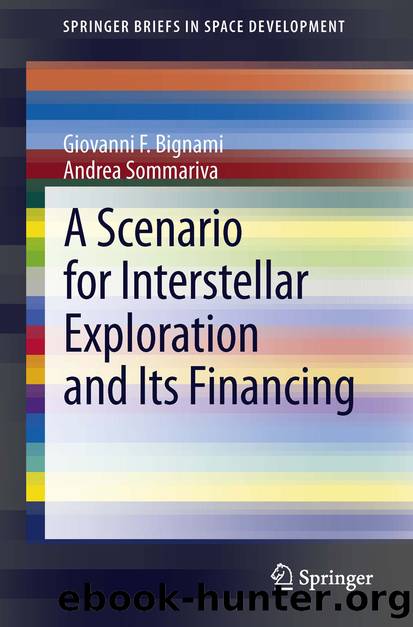A Scenario for Interstellar Exploration and Its Financing by Giovanni F. Bignami & Andrea Sommariva

Author:Giovanni F. Bignami & Andrea Sommariva
Language: eng
Format: epub
Publisher: Springer Milan, Milano
It is difficult to predict at present whether one or another of the propulsion systems described above are engineering feasible. It is not yet clear whether the inertial confinement fusion is technically feasible, casting doubts on the feasibility of the magnetic target fusion, which has the highest exhaust velocity. Another problem to be overcome is the efficient utilization of the several different forms of energy released during a fusion reaction. Only about 20 % of the released energy will be contained in the kinetic energy of the fusion particles. Ten per cent is in the form of IR-UV radiation, but 70 % is released as X-rays. Some authors have analyzed how to reclaim this X-ray energy by using auxiliary laser thrusters, powered by the waste X-rays. If the efficiency of the laser’s X-ray to collimated light conversion process is around 40 %, the laser aided fusion rocket can achieve a velocity of about 10 % of the speed of light with a mass ratio of 20.
The main advantage of fusion would be the very high specific impulse. Starships, powered by nuclear fusion reactions, should conceivably be able to reach speeds of the order of 10 % of the speed of light, based on energy considerations alone. In theory, a large number of stages could push a vehicle close to 30/40 % of the speed of light. In addition, a fusion rocket may produce less radiation than a fission rocket, reducing the mass needed for shielding. The main disadvantage would be the probable large mass of the reactor and the large mass of propellants (hydrogen and deuterium/tritium) that they should carry.
One theoretical spaceship designed to eliminate the need to carry large amount of fuel onboard is the ramjet spaceship. The interstellar ramjet collects interstellar matter to fuel its fusion rockets. As the ramjet moves, ions are caught by its magnetic field scoop which funnels them into a fusion reactor. Within the rocket, energy is released and fed back in some manner into the reaction products. These particles are then used to provide thrust for the vehicle. Most critics of this proposal correctly point out that the ramjet spaceship is not feasible for interstellar travel, since the amount of deuterium present in outer space is minimal.
Another possible way to overcome the problem of carrying large amount of fuel onboard the spaceship is to follow the suggestion of von Braun in his visionary book The Mars Project. Using the words of von Braun:In 1492, Columbus knew less about the far Atlantic than we do about the heavens, yet he chose not to sail with a flotilla of less than three ships, and history tends to prove that he might never had returned to Spanish shores with his report of discoveries had he trusted his fate to a single bottom. So it is for interplanetary exploration. […] The whole expeditionary personnel, together with inanimate objects for the fulfilment of their purpose, must be distributed throughout a flotilla of space vessels.
Download
This site does not store any files on its server. We only index and link to content provided by other sites. Please contact the content providers to delete copyright contents if any and email us, we'll remove relevant links or contents immediately.
International Integration of the Brazilian Economy by Elias C. Grivoyannis(74645)
The Radium Girls by Kate Moore(11619)
Turbulence by E. J. Noyes(7700)
Nudge - Improving Decisions about Health, Wealth, and Happiness by Thaler Sunstein(7241)
The Black Swan by Nassim Nicholas Taleb(6762)
Rich Dad Poor Dad by Robert T. Kiyosaki(6174)
Pioneering Portfolio Management by David F. Swensen(6078)
Man-made Catastrophes and Risk Information Concealment by Dmitry Chernov & Didier Sornette(5646)
Zero to One by Peter Thiel(5488)
Secrecy World by Jake Bernstein(4388)
Millionaire: The Philanderer, Gambler, and Duelist Who Invented Modern Finance by Janet Gleeson(4092)
The Age of Surveillance Capitalism by Shoshana Zuboff(3983)
Skin in the Game by Nassim Nicholas Taleb(3965)
The Money Culture by Michael Lewis(3846)
Bullshit Jobs by David Graeber(3826)
Skin in the Game: Hidden Asymmetries in Daily Life by Nassim Nicholas Taleb(3720)
The Dhandho Investor by Mohnish Pabrai(3560)
The Wisdom of Finance by Mihir Desai(3523)
Blockchain Basics by Daniel Drescher(3328)
